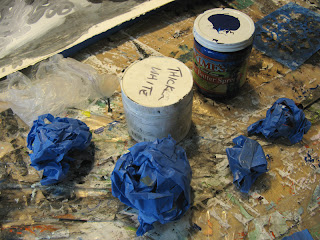Jennifer 'Jay' Katelansky with her work, "The Need To Adorn", on view at the Moore College of Art's Senior Show
My photos don't really do the work justice, but these were the best of the batch that I took. The wall text says in full: "To you the privilege I will not be quiet for your comfort you cannot have this not ever so step the fuck off, baby!"
Since January of this year, I have been acting as an external thesis advisor for Jennifer Katelansky (Jay), who is graduating from Moore College of Art & Design next month. Back in November, I attended an open house event at Moore at the invitation of another Moore student that I used to work with at my job, Stephanie Potter. After visiting Stephanie's studio, I wandered upstairs to the senior studios and wound up having a long conversation with Jay about what she was doing. I was intrigued by some of images that populated Jay's workspace, which included some rough, spare drawings of nude or partially nude black women in various poses, which I later learned were earlier works, while the second work wall was covered, collage-like, with line drawings, books, screen prints, text-based pieces, and photographs. All of these referenced black life from the standpoint of "adornment", which was the basis of Jay's thesis: the use of adornment by African-Americans to stand out visually, as a means of counteracting negative stereotypes as well as to claim visibility in a society that often seems to want to erase or "whitewash" American history of black culture.
The next evening, I received an email from Jay asking me to be her external thesis advisor (students at Moore are able to choose to have one person from outside of the school to be their thesis advisor, in addition to a Moore instructor). I accepted and thus began a four month journey for both of us that wound up being a challenging, but ultimately very rewarding experience. Working with Jay was a pleasure because she's an engaged thinker, is not afraid of challenging herself nor her audience, is passionate about art-making, and perhaps most importantly, is very open to change and eager to learn.
For my part, this experience showed me just how much of the practical and experiential knowledge that I've gained over the years I sometimes take for granted and forget about on a conscious level. Like walking or riding a bike, you internalize a lot of information that you can call up at the drop of a hat. In this situation, I not only had to call up that information, I had to also explain it, as well as be conscious of not interfering too much and overlaying my aesthetic ideals over Jay's work. It was important that I respect her vision and still be able to help her with suggestions. I'm sure that this is something that most people who teach art have to deal with all of the time, but this was new to me. I've talked to students in the past and have been a visiting artist, but I've never been in an advisory role for a sustained amount of time.
All of that has led to this: On Wednesday night (April 24th), the Senior Exhibition at Moore opened and I got to see the completed installation, but the icing on the cake was that she won the "Best of Show" award! I'm very proud of and very happy for her. The past four months were a crucial and challenging time for Jay and her work, but she worked hard came through with a really strong piece that's the start of something great. Congratulations, Jay!!
The Moore College of Art Senior Show continues through May 18th, 2013.













